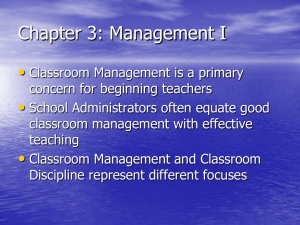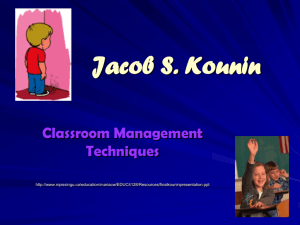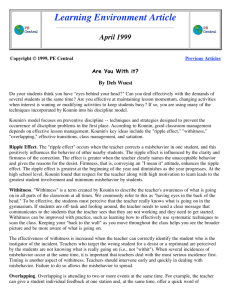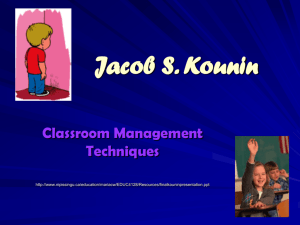Discipline and Group Management in Classrooms
advertisement
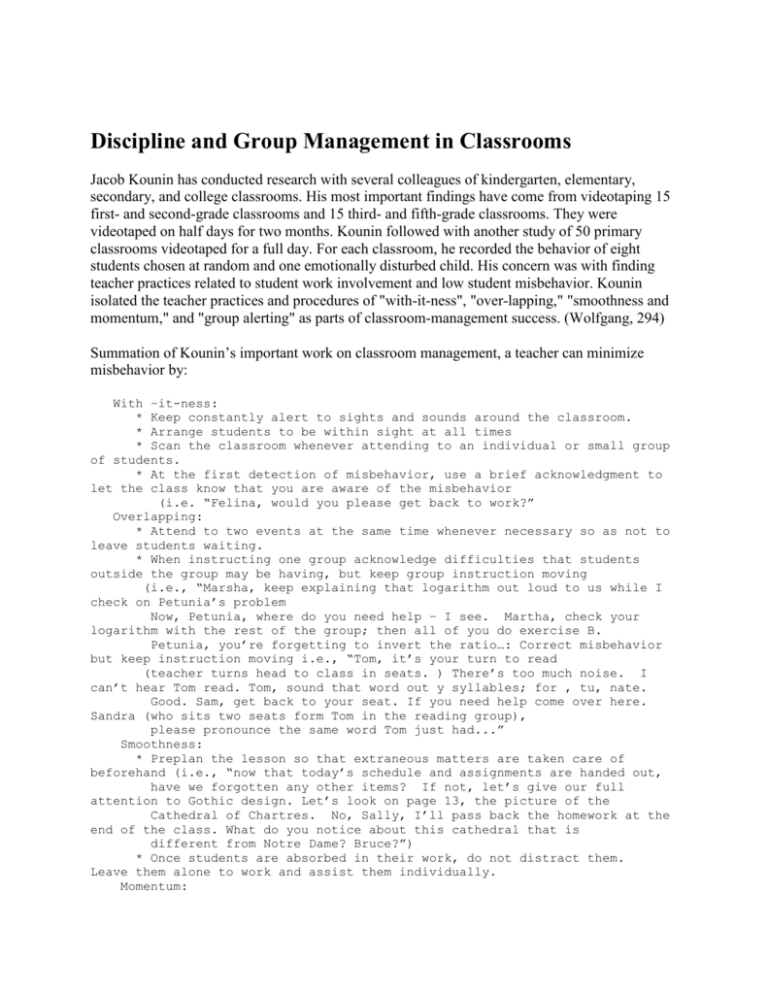
Discipline and Group Management in Classrooms Jacob Kounin has conducted research with several colleagues of kindergarten, elementary, secondary, and college classrooms. His most important findings have come from videotaping 15 first- and second-grade classrooms and 15 third- and fifth-grade classrooms. They were videotaped on half days for two months. Kounin followed with another study of 50 primary classrooms videotaped for a full day. For each classroom, he recorded the behavior of eight students chosen at random and one emotionally disturbed child. His concern was with finding teacher practices related to student work involvement and low student misbehavior. Kounin isolated the teacher practices and procedures of "with-it-ness", "over-lapping," "smoothness and momentum," and "group alerting" as parts of classroom-management success. (Wolfgang, 294) Summation of Kounin’s important work on classroom management, a teacher can minimize misbehavior by: With –it-ness: * Keep constantly alert to sights and sounds around the classroom. * Arrange students to be within sight at all times * Scan the classroom whenever attending to an individual or small group of students. * At the first detection of misbehavior, use a brief acknowledgment to let the class know that you are aware of the misbehavior (i.e. “Felina, would you please get back to work?” Overlapping: * Attend to two events at the same time whenever necessary so as not to leave students waiting. * When instructing one group acknowledge difficulties that students outside the group may be having, but keep group instruction moving (i.e., “Marsha, keep explaining that logarithm out loud to us while I check on Petunia’s problem Now, Petunia, where do you need help – I see. Martha, check your logarithm with the rest of the group; then all of you do exercise B. Petunia, you’re forgetting to invert the ratio…: Correct misbehavior but keep instruction moving i.e., “Tom, it’s your turn to read (teacher turns head to class in seats. ) There’s too much noise. I can’t hear Tom read. Tom, sound that word out y syllables; for , tu, nate. Good. Sam, get back to your seat. If you need help come over here. Sandra (who sits two seats form Tom in the reading group), please pronounce the same word Tom just had...” Smoothness: * Preplan the lesson so that extraneous matters are taken care of beforehand (i.e., “now that today’s schedule and assignments are handed out, have we forgotten any other items? If not, let’s give our full attention to Gothic design. Let’s look on page 13, the picture of the Cathedral of Chartres. No, Sally, I’ll pass back the homework at the end of the class. What do you notice about this cathedral that is different from Notre Dame? Bruce?”) * Once students are absorbed in their work, do not distract them. Leave them alone to work and assist them individually. Momentum: * Keep the lesson moving briskly. * Do not over dwell on a minor or already understood part of the lesson. * Correct students quickly without nagging and return to the lesson. * Have students move from one activity to the next without having to wait for each other on each subpart of the transition (i.e., avoid saying, “First everyone put your pencils away”). Group alerting: * Call on students at random. * Raise group interest by interspersing suspense between questions by saying, “This is a tough one coming up.” “Can you figure this one out?” “You haven’t heard of this before.” “I want you all to think hard before responding.” * Have the entire group or class respond in unison. * Physically move around the room and ask students to show what they have done. * While asking one student to respond, look at other students. Kounin found that with-it-ness, overlapping, smoothness, momentum, and group alerting were the teacher practices most highly related to management success. With-it-ness, overlapping and group alerting are focused teacher behaviors, verbal and non-verbal, in scanning and responding to students. Smoothness and momentum are focused on the organization of the lesson, presentation of instruction, and transitions between work activities. (Wolfgang, 297-98)

